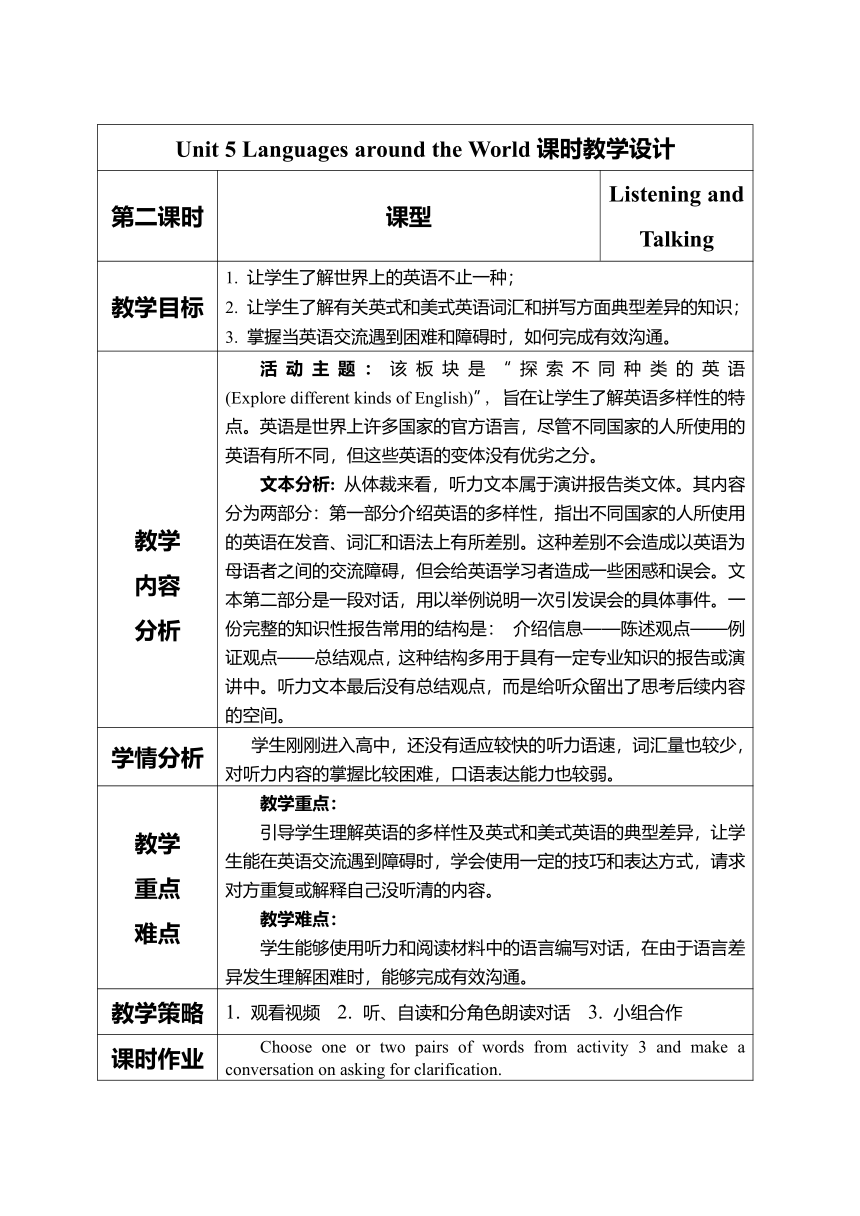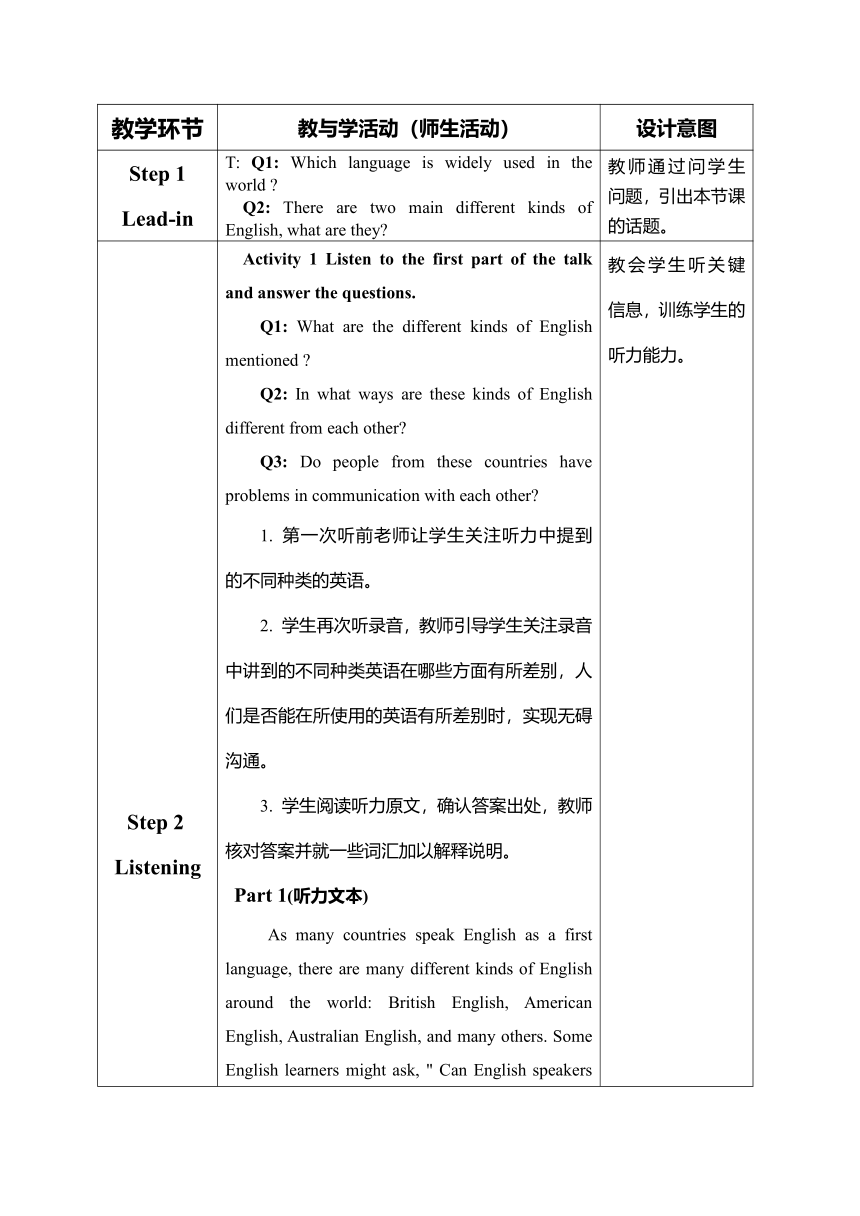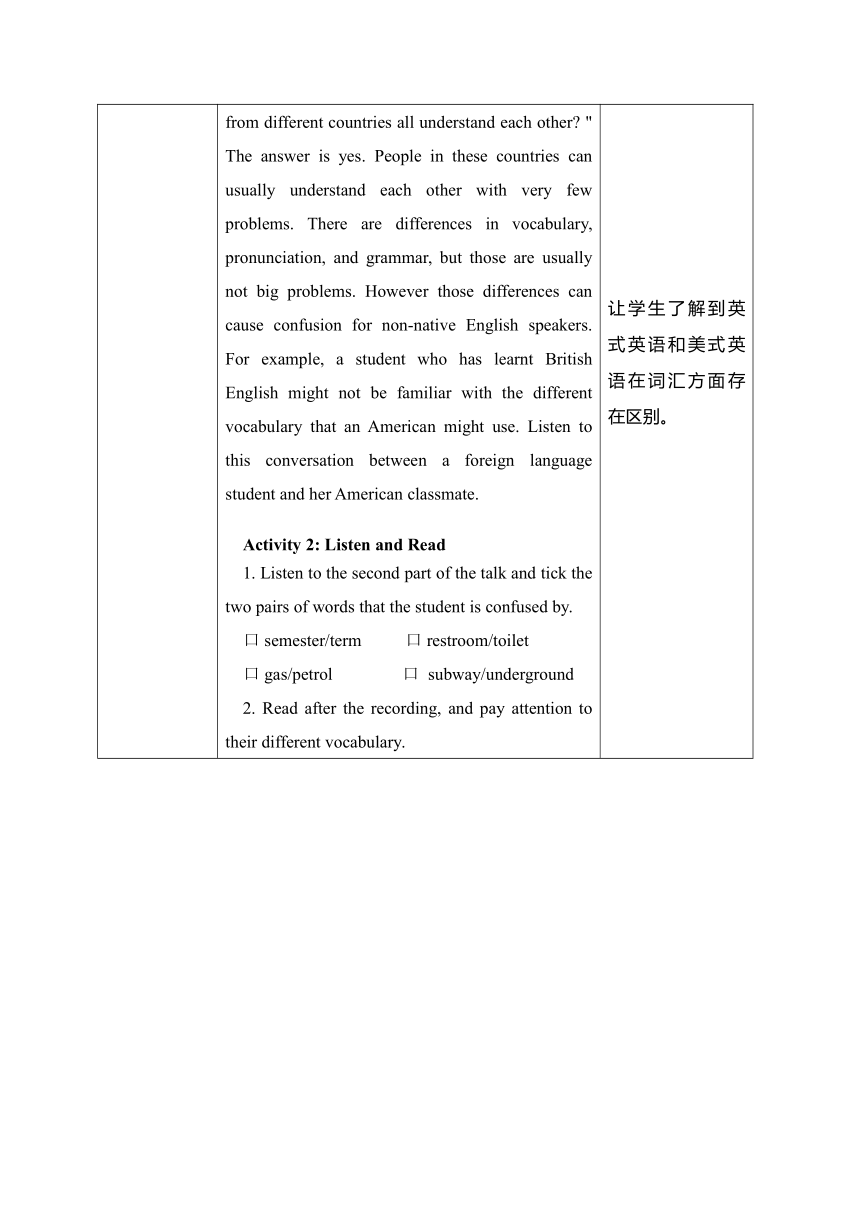Unit 5 Languages around the World Listening and Talking 课时教学设计
文档属性
| 名称 | Unit 5 Languages around the World Listening and Talking 课时教学设计 |  | |
| 格式 | doc | ||
| 文件大小 | 1.4MB | ||
| 资源类型 | 试卷 | ||
| 版本资源 | 人教版(2019) | ||
| 科目 | 英语 | ||
| 更新时间 | 2021-11-26 18:02:37 | ||
图片预览



文档简介
Unit 5 Languages around the World课时教学设计
第二课时 课型 Listening and Talking
教学目标 1. 让学生了解世界上的英语不止一种;2. 让学生了解有关英式和美式英语词汇和拼写方面典型差异的知识;3. 掌握当英语交流遇到困难和障碍时,如何完成有效沟通。
教学内容分析 活动主题:该板块是“探索不同种类的英语(Explore different kinds of English)”, 旨在让学生了解英语多样性的特点。英语是世界上许多国家的官方语言,尽管不同国家的人所使用的英语有所不同,但这些英语的变体没有优劣之分。文本分析: 从体裁来看,听力文本属于演讲报告类文体。其内容分为两部分:第一部分介绍英语的多样性,指出不同国家的人所使用的英语在发音、词汇和语法上有所差别。这种差别不会造成以英语为母语者之间的交流障碍,但会给英语学习者造成一些困惑和误会。文本第二部分是一段对话,用以举例说明一次引发误会的具体事件。一份完整的知识性报告常用的结构是: 介绍信息——陈述观点——例证观点——总结观点, 这种结构多用于具有一定专业知识的报告或演讲中。听力文本最后没有总结观点,而是给听众留出了思考后续内容的空间。
学情分析 学生刚刚进入高中,还没有适应较快的听力语速,词汇量也较少,对听力内容的掌握比较困难,口语表达能力也较弱。
教学重点难点 教学重点:引导学生理解英语的多样性及英式和美式英语的典型差异,让学生能在英语交流遇到障碍时,学会使用一定的技巧和表达方式,请求对方重复或解释自己没听清的内容。教学难点: 学生能够使用听力和阅读材料中的语言编写对话,在由于语言差异发生理解困难时,能够完成有效沟通。
教学策略 1. 观看视频 2. 听、自读和分角色朗读对话 3. 小组合作
课时作业 Choose one or two pairs of words from activity 3 and make a conversation on asking for clarification.
教学环节 教与学活动(师生活动) 设计意图
Step 1Lead-in T: Q1: Which language is widely used in the world Q2: There are two main different kinds of English, what are they 教师通过问学生问题,引出本节课的话题。
Step 2Listening Activity 1 Listen to the first part of the talk and answer the questions.Q1: What are the different kinds of English mentioned Q2: In what ways are these kinds of English different from each other Q3: Do people from these countries have problems in communication with each other 1. 第一次听前老师让学生关注听力中提到的不同种类的英语。2. 学生再次听录音,教师引导学生关注录音中讲到的不同种类英语在哪些方面有所差别,人们是否能在所使用的英语有所差别时,实现无碍沟通。3. 学生阅读听力原文,确认答案出处,教师核对答案并就一些词汇加以解释说明。 Part 1(听力文本) As many countries speak English as a first language, there are many different kinds of English around the world: British English, American English, Australian English, and many others. Some English learners might ask, " Can English speakers from different countries all understand each other " The answer is yes. People in these countries can usually understand each other with very few problems. There are differences in vocabulary, pronunciation, and grammar, but those are usually not big problems. However those differences can cause confusion for non-native English speakers. For example, a student who has learnt British English might not be familiar with the different vocabulary that an American might use. Listen to this conversation between a foreign language student and her American classmate.Activity 2: Listen and Read1. Listen to the second part of the talk and tick the two pairs of words that the student is confused by.口semester/term 口restroom/toilet 口gas/petrol 口 subway/underground2. Read after the recording, and pay attention to their different vocabulary. 教会学生听关键信息,训练学生的听力能力。让学生了解到英式英语和美式英语在词汇方面存在区别。
Step 3Watching and Listening Activity 3: Watching and Listening1. Look at the pairs of words. Which words are British English, and which are American English 2. Watch a video about the differences between British English & American English. 让学生通过具体的例子和观看视频进一步了解英式英语与美式英语的差异。
Step 4Speaking Activity 4 Speaking1. Read and answer the questions.Q1: What does Zhou Wei want to buy Q2: What misunderstanding has happened 2. Read the conversation again and underline the useful expressions for clarification.3. Role-play the conversation.4. Summary for clarification. 学生通过自读和分角色朗读对话,加深对文本熟悉度,为后面的自编对话储备语言支持。
Step 5Work in pairs. Activity 5 Pair Work1. Let students make a conversation with the following pairs of words and expressions of clarification with their partners and then act it out. 通过小组合作编对话,培养学生的合作能力和知识迁移的能力。
Emotional education If you talk to a man in a language he understands, that goes to his head. If you talk to a man in his own language, that goes to his heart. ——Nelson Mandela
Homework Choose one or two pairs of words from activity 3 and make a conversation on asking for clarification.设计意图:巩固本节课所学的内容, 提升学生的知识迁移能力。
板书设计
课时教学 设计反思 听力与表达板块是本单元的第二次听力理解和口语表达训练。在设计本课时时,首先以口语表达为主,听力理解为辅,听力理解是为口语表达服务的。其次,强调目标引领,重视口语表达的情境设置,将口语表达的目标落实在学生能够用语言做什么上,从而搭建口语表达的支架,帮助学生进行有效的口语表达。
说是听说课的核心。在听说课上,教师要指导学生正确的单词发音和通用的发音规律,让学生模仿英美发音,让每个学生都敢张口说,改变以往中国学生重写不重说的语言学习的不足。
总之,提高学生的听力和口语表达能力是一个长期的过程,需要我们英语老师通过不懈的努力来改进和完善我们的教学方法。
第二课时 课型 Listening and Talking
教学目标 1. 让学生了解世界上的英语不止一种;2. 让学生了解有关英式和美式英语词汇和拼写方面典型差异的知识;3. 掌握当英语交流遇到困难和障碍时,如何完成有效沟通。
教学内容分析 活动主题:该板块是“探索不同种类的英语(Explore different kinds of English)”, 旨在让学生了解英语多样性的特点。英语是世界上许多国家的官方语言,尽管不同国家的人所使用的英语有所不同,但这些英语的变体没有优劣之分。文本分析: 从体裁来看,听力文本属于演讲报告类文体。其内容分为两部分:第一部分介绍英语的多样性,指出不同国家的人所使用的英语在发音、词汇和语法上有所差别。这种差别不会造成以英语为母语者之间的交流障碍,但会给英语学习者造成一些困惑和误会。文本第二部分是一段对话,用以举例说明一次引发误会的具体事件。一份完整的知识性报告常用的结构是: 介绍信息——陈述观点——例证观点——总结观点, 这种结构多用于具有一定专业知识的报告或演讲中。听力文本最后没有总结观点,而是给听众留出了思考后续内容的空间。
学情分析 学生刚刚进入高中,还没有适应较快的听力语速,词汇量也较少,对听力内容的掌握比较困难,口语表达能力也较弱。
教学重点难点 教学重点:引导学生理解英语的多样性及英式和美式英语的典型差异,让学生能在英语交流遇到障碍时,学会使用一定的技巧和表达方式,请求对方重复或解释自己没听清的内容。教学难点: 学生能够使用听力和阅读材料中的语言编写对话,在由于语言差异发生理解困难时,能够完成有效沟通。
教学策略 1. 观看视频 2. 听、自读和分角色朗读对话 3. 小组合作
课时作业 Choose one or two pairs of words from activity 3 and make a conversation on asking for clarification.
教学环节 教与学活动(师生活动) 设计意图
Step 1Lead-in T: Q1: Which language is widely used in the world Q2: There are two main different kinds of English, what are they 教师通过问学生问题,引出本节课的话题。
Step 2Listening Activity 1 Listen to the first part of the talk and answer the questions.Q1: What are the different kinds of English mentioned Q2: In what ways are these kinds of English different from each other Q3: Do people from these countries have problems in communication with each other 1. 第一次听前老师让学生关注听力中提到的不同种类的英语。2. 学生再次听录音,教师引导学生关注录音中讲到的不同种类英语在哪些方面有所差别,人们是否能在所使用的英语有所差别时,实现无碍沟通。3. 学生阅读听力原文,确认答案出处,教师核对答案并就一些词汇加以解释说明。 Part 1(听力文本) As many countries speak English as a first language, there are many different kinds of English around the world: British English, American English, Australian English, and many others. Some English learners might ask, " Can English speakers from different countries all understand each other " The answer is yes. People in these countries can usually understand each other with very few problems. There are differences in vocabulary, pronunciation, and grammar, but those are usually not big problems. However those differences can cause confusion for non-native English speakers. For example, a student who has learnt British English might not be familiar with the different vocabulary that an American might use. Listen to this conversation between a foreign language student and her American classmate.Activity 2: Listen and Read1. Listen to the second part of the talk and tick the two pairs of words that the student is confused by.口semester/term 口restroom/toilet 口gas/petrol 口 subway/underground2. Read after the recording, and pay attention to their different vocabulary. 教会学生听关键信息,训练学生的听力能力。让学生了解到英式英语和美式英语在词汇方面存在区别。
Step 3Watching and Listening Activity 3: Watching and Listening1. Look at the pairs of words. Which words are British English, and which are American English 2. Watch a video about the differences between British English & American English. 让学生通过具体的例子和观看视频进一步了解英式英语与美式英语的差异。
Step 4Speaking Activity 4 Speaking1. Read and answer the questions.Q1: What does Zhou Wei want to buy Q2: What misunderstanding has happened 2. Read the conversation again and underline the useful expressions for clarification.3. Role-play the conversation.4. Summary for clarification. 学生通过自读和分角色朗读对话,加深对文本熟悉度,为后面的自编对话储备语言支持。
Step 5Work in pairs. Activity 5 Pair Work1. Let students make a conversation with the following pairs of words and expressions of clarification with their partners and then act it out. 通过小组合作编对话,培养学生的合作能力和知识迁移的能力。
Emotional education If you talk to a man in a language he understands, that goes to his head. If you talk to a man in his own language, that goes to his heart. ——Nelson Mandela
Homework Choose one or two pairs of words from activity 3 and make a conversation on asking for clarification.设计意图:巩固本节课所学的内容, 提升学生的知识迁移能力。
板书设计
课时教学 设计反思 听力与表达板块是本单元的第二次听力理解和口语表达训练。在设计本课时时,首先以口语表达为主,听力理解为辅,听力理解是为口语表达服务的。其次,强调目标引领,重视口语表达的情境设置,将口语表达的目标落实在学生能够用语言做什么上,从而搭建口语表达的支架,帮助学生进行有效的口语表达。
说是听说课的核心。在听说课上,教师要指导学生正确的单词发音和通用的发音规律,让学生模仿英美发音,让每个学生都敢张口说,改变以往中国学生重写不重说的语言学习的不足。
总之,提高学生的听力和口语表达能力是一个长期的过程,需要我们英语老师通过不懈的努力来改进和完善我们的教学方法。
